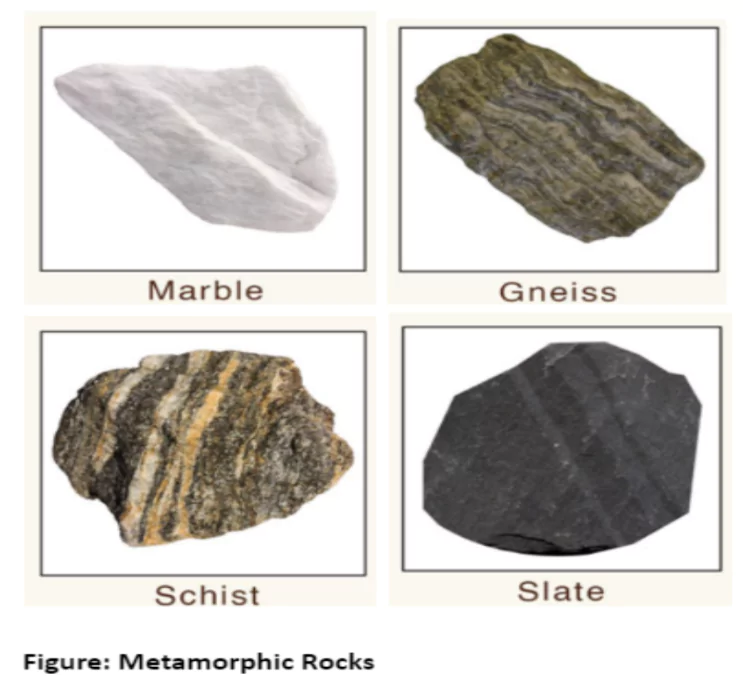Metamorphic rocks are rocks that have transformed due to intense heat and pressure deep within the Earth. This process, called metamorphism, rearranges the minerals within the original rock, resulting in new textures and structures. Metamorphic rocks can form through different processes like dynamic, thermal, contact, or regional metamorphism, often displaying features like foliation or banding.
Metamorphic Processes and Features
- Metamorphism is a process by which already consolidated rocks undergo recrystallisation and reorganisation of materials within the original rocks due to changes in pressure, volume, and temperature.
- Metamorphism also refers to the alteration or “change of form” of rocks.
- Metamorphism occurs when rocks are subjected to tectonic forces pushing them to lower depths or when molten magma contacts crustal rocks.
- Foliation or Lineation: In the process of metamorphism in some rocks, grains or minerals get arranged in layers or lines. Such an arrangement of minerals or grains in metamorphic rocks is called foliation or lineation.
- Banding: Sometimes minerals or materials of different groups are arranged into alternating thin to thick layers, appearing in light and dark shades.
- Rocks displaying banding are called banded rocks.
- Features of Metamorphic Rocks:
- Formed due to pressure and temperature.
- Very smooth in texture & consists of layers sometimes.
- Exhibit a wide range of colours.
- Rarely contain fossils.

| Original Rock |
Metamorphic Rock |
| Granite |
Gneiss |
| Basalt |
Hornblend |
| Limestone |
Marble |
| Coal |
Graphite |
| Sandstone |
Quartzite |
| Shale |
Slate |
Factors Contributing to Metamorphism
- Orogenic movement: Also known as mountain building process, occurs through folding, warping, and high temperatures, transforming existing rocks.
- Movement of Lava: inflow from molten magmatic material in the Earth’s crust subjects surrounding rocks to intense temperature and pressure, inducing changes.
- Geodynamic forces: like plate tectonics, are ever-present and significant contributors to metamorphism.
Enroll now for UPSC Online Course
Types of Metamorphism
- Dynamic Metamorphism: Mechanical disruption and reorganisation of the original minerals within rocks due to breaking and crushing without any appreciable chemical changes.
- Thermal Metamorphism: It causes materials in rocks to chemically alter and recrystallise.
- Contact Metamorphism: Rocks come in contact with hot intruding magma and lava and the rock materials recrystallise under high temperatures
- Regional Metamorphism: Rocks undergo recrystallisation due to deformation caused by tectonic shearing together with high-temperature, pressure, or both.
Metamorphic Rocks Across India
- Gneisses and Schists: Commonly observed in the Himalayas, Assam, West Bengal, Bihar, Orissa, Madhya Pradesh, and Rajasthan.
- Quartzite: is abundant in Rajasthan, Bihar, Madhya Pradesh, Tamil Nadu, and areas surrounding Delhi.
- Marble: Found in Alwar, Ajmer, Jaipur, Jodhpur in Rajasthan, and parts of the Narmada Valley in Madhya Pradesh.
- Slate: Found in Rewari (Haryana), Kangra (Himachal Pradesh), and some regions of Bihar.
- Graphite: Found in Orissa and Andhra Pradesh.
Conclusion
Metamorphic rocks, formed by intense heat and pressure deep within the Earth, showcase diverse textures and colours. Their creation involves dynamic processes like orogenic movement, lava inflow, and geodynamic forces. These rocks, such as gneisses, schists, quartzites, and marbles, are found across India, each region exhibiting its unique geological features. Understanding metamorphic rocks helps us grasp the Earth’s dynamic history and aids various industries, from construction to mining.
![]() April 26, 2024
April 26, 2024
![]() 2709
2709
![]() 0
0
